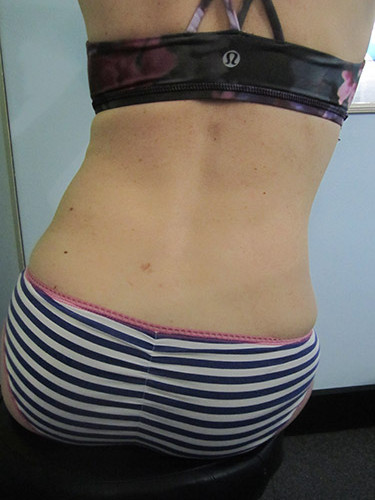The health risks associated with the increasing amounts of sitting we do through work and ‘play’ in our technological age is beginning to attract more interest.
A recent newspaper article: ‘Sitting is the new smoking’ draws attention to the metabolic costs of increasingly sedentary behaviours – obesity, heart disease, Type 2 diabetes and even ones lifespan. Our skeletal body also suffers – with stiffness, ‘aches and pains’.
It is estimated that 77% of many people’s work day is spent sitting – and up to 62% on non-work days! For more alarming statistics, read the report, Stand Up Australia.
Sitting is here to stay so we had better get it right.
HOW we sit is decisively important for our musculoskeletal health and general well-being or otherwise.
Simple as it seems, most of us can’t ‘sit up’ properly – let alone sustain the posture.

 Fig 2: ‘Sitting up’ is achieved using excess muscle tension which is both tiring and creates further problems – and he’ll soon revert to slump!
Fig 2: ‘Sitting up’ is achieved using excess muscle tension which is both tiring and creates further problems – and he’ll soon revert to slump! Fig 3: The First Fundamental Pelvic pattern underlies the ability to ‘come up onto’ the sit bones and create an active base of support from the base of the spine.
Fig 3: The First Fundamental Pelvic pattern underlies the ability to ‘come up onto’ the sit bones and create an active base of support from the base of the spine. Fig 4: Lateral weight shift is achieved through the Forth Fundamental Pelvic Pattern.
Fig 4: Lateral weight shift is achieved through the Forth Fundamental Pelvic Pattern. Fig 5: Rotation in the horizontal plane is achieved through the Third Fundamental Pelvic Pattern.
Fig 5: Rotation in the horizontal plane is achieved through the Third Fundamental Pelvic Pattern.Most of us have lost the sense of easily assuming the natural, relaxed sitting posture. We either collapse (Fig. 1) or try and ‘hold ourselves up’ using excess muscle tension (Fig. 2) (see ‘What you should know about sitting properly‘). Either way, the altered tissue loading eventually begins to affect the whole spine and much of the nervous system.
Yet we are surprised when pains arise.
Back pain affects around 80% of Australians. And slump-sitting is probably one of the most pernicious root causes of most back pain – and a multitude of other related symptoms.
Without exception, we have observed that at the initial assessment all the patients attending our clinic habitually slouch/slump sit – it’s a potent, ‘elusive obvious’ contributor to disc, joint and soft tissue wear and tear and eventual pain syndromes in the spine and pelvis.
One could posit lots of reasons for sloppy sitting – the fact is, the longer you spend there the more you are likely to slump – unless you are mindful of doing otherwise.
If you always slump, you are switching off your ‘core’ – this begins to ‘feel normal’. Without proper support, the pelvic and spinal joints are pushed to their limits. They eventually ‘set’ there – even when you stand and during other functional movements like bending over – and even when exercising! The tissues never get a break!
This prolonged ‘end range’ cyclic loading of the spine has been shown to induce multi component tissue changes including inflammation, pain and neuromuscular hyper-excitability (Solomonow 2012).
Learn to help yourself:
Slumping switches off your core muscles. Research has shown that when the pelvis and spine are in the ‘neutral’ upright position, the deep ‘core muscles’ naturally switch on. It’s stupid to try and ‘exercise your core’ if you habitually switch it off all day long!
Proper sitting involves balancing on your sit bones and allowing your tail bone to come back so that your spine can assume its natural curves – and you can breathe easily.
This is achieved by the First Fundamental Pelvic Pattern. But if you always slump, this becomes rusty and ‘forgotten’ (see my post, Strengthening ‘the glutes’: Helpful of harmful).
To compensate, you will use excess muscle tension around the central torso (Fig. 2) I have termed this Central Cinch Pattern behaviour. This creates further problems for the spine’s movement and postural control, your breathing and possibly your continence.
The ability to control The Fundamental Pelvic Patterns provides the real foundations of healthy spinal control when ‘up’ against gravity – sitting and standing. Properly supported from below, the spine has an ‘inner lift’ and can easily assume its natural ‘neutral’ curves (Fig. 3).
The ability to further weight shift through the pelvis also allows the initiation of movement from the base of the spine and adaptive movements through the spine. (Figs. 4 & 5)
Importantly, these Fundamental Patterns can all be practised, sitting on a chair!
You can be giving your ‘core’ a fantastic workout all day long – if you are mindful and choose to do so!
Leave a Reply